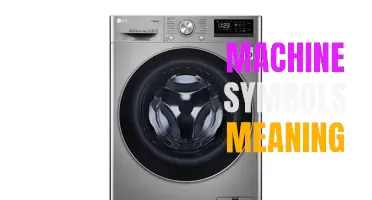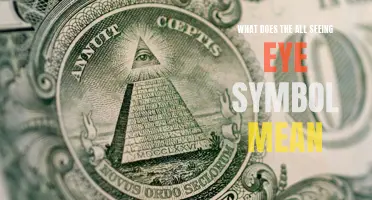
Surface finish symbols are graphic representations used to communicate the desired surface texture or quality of a product. These symbols are an essential part of technical drawings and provide valuable information to manufacturing and inspection teams. Understanding these symbols is critical for ensuring that the finished product meets the required standards and specifications. From rough to smooth, gritty to glossy, surface finish symbols provide a universal language that allows engineers, designers, and manufacturers to speak the same aesthetic and functional texture in the world of manufacturing. So, let's explore the world of surface finish symbols and uncover their meanings and importance in the world of product development.
What You'll Learn
- What are surface finish symbols and why are they used?
- How are surface finish symbols interpreted and what do they signify?
- Are there standard symbols and meanings for surface finishes, or do they vary across industries or regions?
- Can you provide examples of different surface finish symbols and their corresponding meanings?
- How important is it for engineers and manufacturers to accurately communicate and interpret surface finish symbols in technical drawings?

What are surface finish symbols and why are they used?
Surface finish symbols are graphical representations that indicate the quality of a finished surface on a manufactured part. They are commonly used in engineering and manufacturing industries to communicate the desired surface finish to the craftsmen or machine operators who will be working on the part.
The purpose of surface finish symbols is to ensure consistency and accuracy in the finished product. By specifying the required surface finish using symbols, engineers can avoid any confusion or misinterpretation that may arise when using written descriptions alone. Surface finish symbols provide a standardized and universally understood language for communicating surface finish requirements.
Surface finish symbols typically consist of a letter or letters followed by a number. The letter represents the manufacturing process that will be used to achieve the desired surface finish, while the number indicates the roughness or smoothness of the surface. Commonly used symbols include:
- RA: This symbol represents the arithmetic average value of surface roughness. It is expressed in micrometers (μm) and indicates the average height deviation of the surface features from the ideal surface.
- RZ: This symbol represents the maximum peak-to-valley height of surface roughness. It is also expressed in micrometers (μm) and indicates the maximum distance between the highest peak and the lowest valley on the surface.
- N: This symbol represents the surface roughness grade. It is followed by a number that ranges from 1 to 12, with 1 being the smoothest and 12 being the roughest.
These symbols are typically placed below the feature control frame on engineering drawings, indicating the desired surface finish for that particular feature. They are often accompanied by additional specifications, such as machining allowances, surface treatment requirements, or inspection methods.
The use of surface finish symbols provides several benefits. Firstly, they ensure that all parties involved in the manufacturing process are on the same page regarding the required surface finish. This eliminates any ambiguity or confusion and ensures that the finished product meets the desired specifications.
Secondly, surface finish symbols help to standardize surface finish specifications across different manufacturing processes and industries. This allows for easy comparison of surface finishes and facilitates the exchange of information between manufacturers, designers, and customers.
Lastly, surface finish symbols assist in the selection of appropriate manufacturing processes and control methods. By specifying the desired surface finish, engineers can choose the most suitable machining techniques, cutting tools, or surface treatment processes to achieve the desired result. The symbols also guide quality control personnel in conducting surface roughness inspections and ensuring compliance with specifications.
In conclusion, surface finish symbols are an essential tool in the engineering and manufacturing industries. They provide a standardized language for communicating surface finish requirements, ensuring consistency and accuracy in the finished product. By using these symbols, engineers can effectively convey their expectations to craftsmen and machine operators, facilitate the selection of appropriate manufacturing processes, and ensure the desired surface finish is achieved.
The Symbolic Meaning of the White Butterfly: Unveiling Messages from the Spirit Realm
You may want to see also

How are surface finish symbols interpreted and what do they signify?
Surface finish symbols are a standardized way to communicate the desired surface finish of a manufactured part. These symbols are typically included on engineering drawings and provide valuable information to the machining and manufacturing teams.
Interpreting surface finish symbols requires an understanding of the specific symbol and its associated parameters. There are several common symbols used to depict surface finish:
- Roughness symbol (Ra): This symbol indicates the average surface roughness value of the part. The roughness value is typically represented in micrometers and is a measure of the height variations on the surface. A smaller Ra value indicates a smoother surface finish.
- Lay symbol (W): The lay symbol represents the direction of the surface pattern or texture. It is typically shown as a series of lines and can indicate whether the surface has been machined, ground, or textured in a specific way.
- Peak-to-valley height (Rz): This symbol represents the difference in height between the highest peak and lowest valley on the surface. It provides an indication of the overall surface roughness and is often used in conjunction with the Ra symbol.
- Surface waviness symbol (Wt): This symbol represents the deviations from the nominal surface profile and is typically used to specify waviness or undulations on the surface. Wt values are usually given in micrometers or inches.
In addition to these symbols, there may be additional information provided such as surface treatment requirements, allowable defects, or specific industry standards that should be followed.
It is important to note that surface finish symbols can vary depending on the standard being used. The most commonly used standard is the ANSI/ASME Y14.36M standard, but other standards such as ISO 1302 or DIN 4768 may also be used.
To properly interpret surface finish symbols, it is important to consult the appropriate standard and reference any associated documentation or specifications. Machinists and manufacturing teams should be familiar with these symbols and have the necessary tools and techniques to achieve the desired surface finish.
In summary, surface finish symbols are a critical part of communicating the desired surface finish of a manufactured part. They provide valuable information about surface roughness, lay, peak-to-valley height, and waviness. Interpreting these symbols requires an understanding of the specific parameters and the applicable standard. By following these symbols, manufacturers can ensure that the finished parts meet the desired surface finish requirements.
Unveiling the Profound Meanings of Kabbalah Symbols
You may want to see also

Are there standard symbols and meanings for surface finishes, or do they vary across industries or regions?
Surface finishes are an essential aspect of manufacturing and engineering processes, ensuring that products are not only aesthetically pleasing but also meet certain functional requirements. However, the symbols and meanings associated with surface finishes can vary across industries and regions.
In many industries, there are standard symbols used to denote specific surface finishes. These symbols are typically based on internationally recognized standards, such as those published by the International Organization for Standardization (ISO). These symbols are used to communicate the desired surface finish to suppliers and manufacturers, ensuring that everyone involved in the production process is clear on the requirements.
One commonly used system for surface finish symbols is the Ra (roughness average) system. The Ra value represents the average roughness of the surface and is typically expressed in micrometers (μm) or microinches (μin). The Ra value is denoted by a symbol that resembles the letter "R" followed by a number value.
For example, an Ra value of 0.8 μm would be represented by the symbol "Rz0.8". This symbol indicates that the surface finish should have an average roughness of 0.8 μm. In addition to the Ra value, other surface finish parameters may be specified, such as the direction of the surface texture, waviness, and lay.
While these symbols and meanings are widely recognized in many industries, variations can still exist. Different industries may have their own specific symbols and meanings for surface finishes, particularly if they have unique requirements or standards.
Furthermore, regional variations also exist in surface finish symbols and meanings. For example, while the ISO system is commonly used in Europe and many other parts of the world, the American National Standards Institute (ANSI) has its own system for surface finish symbols known as the AA (Arithmetic Average) system.
The AA system uses a different set of symbols to denote surface finishes, for example, "AA-C-2.0" represents a surface finish with an average roughness of 2.0 microinches. These regional differences can create confusion and potential issues if suppliers and manufacturers from different regions are working together.
To minimize misunderstandings and ensure clear communication, it is crucial for all parties involved in a manufacturing or engineering process to agree upon the surface finish symbols and meanings upfront. This can be done by referencing internationally recognized standards like ISO or ANSI, or by establishing industry-specific standards within a particular region.
In conclusion, while there are standard symbols and meanings for surface finishes in many industries, the specific symbols and meanings can vary across industries and regions. It is important for all parties involved to agree upon the symbols and meanings upfront to ensure clear communication and meet the desired surface finish requirements.
Decoding the Symbols on Your Air Fryer: What Do They Mean?
You may want to see also

Can you provide examples of different surface finish symbols and their corresponding meanings?
Surface finish symbols are used in engineering drawings to communicate the desired finish for a specific surface. These symbols are standardized and provide clear instructions to manufacturers and machinists. There are various types of surface finish symbols, each representing a different type of finish. Here are some examples of commonly used surface finish symbols and their corresponding meanings:
- Ra: This symbol represents the arithmetic average of the surface roughness of a part. It is a numerical value that indicates the deviation of the actual surface from the ideal surface. The smaller the Ra value, the smoother the surface finish.
- Rz: This symbol represents the maximum height of the surface roughness profile within a sampling length. It indicates the peak-to-valley roughness of a part. A smaller Rz value indicates a smoother surface finish.
- N: This symbol represents the surface roughness in micrometers (µm). It is used when a specific roughness value is required for a surface.
- V: This symbol represents the number of surface imperfections, such as pits or scratches, allowed on a surface. It is used to indicate the maximum acceptable level of surface defects.
- M: This symbol represents the method used to achieve the desired surface finish. It can be used to indicate processes such as grinding, polishing, or honing.
- G: This symbol represents the surface texture. It can indicate whether a surface should be smooth, rough, or have a specific pattern.
These are just a few examples of surface finish symbols and their meanings. It is important to note that the specific symbols used may vary depending on the standards followed in a particular industry or country. It is always recommended to consult the appropriate standards or consult with a design engineer to ensure accurate communication of surface finish requirements.
Decoding the Red Lightning Bolt: Understanding Jeep Dashboard Symbols
You may want to see also

How important is it for engineers and manufacturers to accurately communicate and interpret surface finish symbols in technical drawings?
Engineering and manufacturing industries rely heavily on technical drawings to communicate design specifications and requirements. These drawings include a range of information, from dimensions and tolerances to surface finish symbols. Surface finish symbols are essential for ensuring that the finished product meets the required functional and aesthetic standards. Therefore, it is crucial for engineers and manufacturers to accurately communicate and interpret these symbols.
Surface finish symbols on technical drawings provide clear instructions on the desired texture and appearance of the surface. They convey important information about the roughness, waviness, and other characteristics of the surface, which directly affect the performance, durability, and functionality of the product. For example, in aerospace engineering, surface finishes are critical for ensuring proper airflow and reducing friction, which contribute to overall fuel efficiency and performance.
Accurate communication and interpretation of surface finish symbols are vital for several reasons. Firstly, they help engineers and manufacturers to make informed decisions during the design and manufacturing processes. By understanding the intended surface finish, engineers can select suitable materials, machining techniques, and processes to achieve the desired outcome. This ensures that the final product will meet all necessary specifications and requirements.
Secondly, accurate interpretation of surface finish symbols ensures consistent quality across different manufacturing processes and suppliers. It allows engineers and manufacturers to specify the required level of precision and uniformity, reducing inconsistencies and variations in the finished product. This is particularly important in industries where components or parts are manufactured by different suppliers and then assembled together, such as automotive or electronics industries.
Surface finish symbols also play a crucial role in communication between different stakeholders involved in the design and manufacturing processes. Engineers and designers use these symbols to convey their requirements to manufacturers, who need to understand and interpret them correctly to produce the desired surface finish. Similarly, manufacturers must accurately communicate the actual surface finishes achieved during the manufacturing process back to engineers to ensure that the final product meets all specifications.
Failure to accurately communicate and interpret surface finish symbols can lead to several issues. Firstly, it can result in products that do not meet the desired functional or aesthetic standards. For example, if a surface is intended to have a specific roughness or texture, but this is not accurately communicated or interpreted, the finished product may not perform as expected or meet customer expectations. This can result in costly rework or even product recalls.
Furthermore, inaccurate communication and interpretation of surface finish symbols can lead to misalignment between manufacturers and designers. If manufacturers do not understand the requirements or if engineers are unaware of the actual surface finishes achieved, it can lead to disputes, delays, and additional costs. This can significantly impact the overall efficiency and profitability of the design and manufacturing processes.
In conclusion, accurate communication and interpretation of surface finish symbols in technical drawings are crucial for engineers and manufacturers. They provide vital information about the desired texture and appearance of the surface, ensuring that the final product meets functional and aesthetic requirements. These symbols enable informed decision-making, ensure consistent quality, and foster effective communication between different stakeholders. Failure to accurately communicate and interpret surface finish symbols can result in products that do not meet specifications, leading to costly rework and disputes. Therefore, engineers and manufacturers must prioritize the accurate communication and interpretation of surface finish symbols to ensure high-quality and reliable products.
Understanding Crochet Symbols: Their Meaning and Usage
You may want to see also
Frequently asked questions
The symbol Ra in surface finish symbols represents the arithmetic average roughness. It is a measure of the average deviation of the surface from its ideal form. Ra values are given in micrometers (µm) and provide information about the roughness of a surface.
The symbol Rz in surface finish symbols represents the maximum peak-to-valley height of the surface irregularities. It is a measure of the vertical distance between the highest peak and the lowest valley within a specified sampling length. Rz values are given in micrometers (µm) and provide information about the overall roughness of a surface.
The symbol Rt in surface finish symbols represents the total roughness. It is a measure of the vertical distance between the highest peak and the lowest valley within the entire sampling length. Rt values are given in micrometers (µm) and provide information about the extreme roughness of a surface.
The symbol N in surface finish symbols represents the number of sampling lengths used to assess the surface roughness. It is typically expressed as a single digit following the roughness value. The higher the number, the more reliable and accurate the measurement.
The symbol µm in surface finish symbols represents micrometers, which is a unit of measurement for surface roughness. It is equivalent to one millionth of a meter and is commonly used to express the values of Ra, Rz, and Rt in surface finish specifications.







